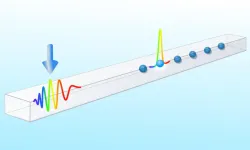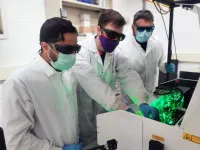New clinical method could lower risk of recurring heart attacks
2021-03-12
(Press-News.org) Researchers at Lund University in Sweden can now show that a new examination method identifies high-risk plaques in the blood vessels surrounding the heart, that cannot be seen solely with traditional angiograms. This type of plaque, rich in fat, could potentially cause recurring heart attacks in patients with heart disease. The study is published in the The Lancet.
"We have been working on this study for ten years. This creates a unique opportunity to treat plaques before they cause a heart attack", says David Erlinge, professor of cardiology at Lund University and Consultant in Interventional Cardiology at Skåne University Hospital, who together with researchers in New York led the study.
The results show that over fourteen percent of the treated patients had some form of heart disease recurrence within four years. In eight percent of the cases, the cause was high-risk plaque that was not detected in a previous angiogram.
Several autopsy studies have previously shown that vulnerable plaques are the underlying cause of most coronary heart disease. When a plaque ruptures and forms one or more clots, they cause the majority of heart attacks and infarction-related sudden death.
"This a major step forward for cardiology," said co-author James Muller, MD, of the Division of Cardiovascular Medicine at Brigham and Women's Hospital in Boston, Mass. "This study has demonstrated a superior way to quantify risk at the plaque level and to identify patients who are at increased risk of experiencing adverse cardiac events."
The new method, known as NIRS (Near-Infrared Spectroscopy) and IVUS (Intravascular Ultrasound), uses infrared light and ultrasound. The examination of the patient is typically performed with a catheter brought to the heart area via the wrist, and done in connection with an angiogram. The high-fat plaques can then be seen in yellow on a color-coded map.
"An angiogram only reveals a shadow of the vessel walls, not what is in the wall. With the new NIRS-IVUS method, we can see vulnerable plaque there as well", says David Erlinge.
The study included 898 patients from 16 hospitals in Sweden, Denmark and Norway. All had suffered a heart attack and were treated with balloon dilation and stents in the coronary arteries. 14.4 percent of the patients in the study experienced new issues within four years of the heart attack. In 8 percent of the patients, the direct cause was untreated plaque. A total of 3,629 untreated plaques were found, which is an average of about four per treated patient.
"The study shows that most of the subsequent cardiac events were caused by plaque not revealed in previous examinations using angiograms and physiological pressure measurements, which are the methods used clinically today", says David Erlinge.
The next big question is how to treat these plaques. The researchers included a small treatment study that showed that stenting of dangerous plaques opened up the vessel and halved the number of cardiac events. This needs to be confirmed by larger studies, however.
INFORMATION:
ELSE PRESS RELEASES FROM THIS DATE:
2021-03-12
During 1995-2015, fullerene derivatives had been the dominating electron acceptors in organic solar cells (OSCs) owing to their performance superior to other acceptors. However, the drawbacks of fullerenes, such as weak visible absorption, limited tunability of electronic properties and morphological instability, restrict further development of OSCs toward higher efficiencies and practical applications. Therefore, the development of new acceptors beyond fullerenes is urgent in the field of OSCs.
Professor Zhan Xiaowei from the College of Engineering at Peking University is one of the pioneers engaging in development of nonfullerene acceptors in the world. ...
2021-03-12
University of Otago researchers have discovered one of the reasons why more than 50 per cent of people with type 2 diabetes die from heart disease.
And perhaps more significantly, they have found how to treat it.
Associate Professor Rajesh Katare, of the Department of Physiology, says it has been known that stem cells in the heart of diabetic patients are impaired. While stem cell therapy has proved effective in treating heart disease, it is not the case in diabetic hearts.
It has not been known why; until now.
It comes down to tiny molecules called microRNA which control gene expression.
"Based on the results of laboratory testing, ...
2021-03-12
New bioarchaeological research shows malaria has threatened human communities for more than 7000 years, earlier than when the onset of farming was thought to have sparked its devastating arrival.
Lead author Dr Melandri Vlok from the Department of Anatomy, University of Otago, says this ground-breaking research, published today in Scientific Reports, changes the entire understanding of the relationship humans have had with malaria, still one of the deadliest diseases in the world.
"Until now we've believed malaria became a global threat to humans when we turned to farming, but our research shows in at least Southeast Asia this disease was a threat to human groups well before that.
"This research providing a new cornerstone of malaria's evolution with humans is a great achievement ...
2021-03-12
When people think of sea level rise, they usually think of coastal erosion. However, recent computer modeling studies indicate that coastal wastewater infrastructure, which includes sewer lines and cesspools, is likely to flood with groundwater as sea-level rises.
A new study, published by University of Hawai'i (UH) at Mānoa earth scientists, is the first to provide direct evidence that tidally-driven groundwater inundation of wastewater infrastructure is occurring today in urban Honolulu, Hawai'i. The study shows that higher ocean water levels ...
2021-03-12
Light-emitting diodes (LEDs) have revolutionized the displays industry. LEDs use electric current to produce visible light without the excess heat found in traditional light bulbs, a glow called electroluminescence. This breakthrough led to the eye-popping, high-definition viewing experience we've come to expect from our screens. Now, a group of physicists and chemists have developed a new type of LED that utilizes spintronics without needing a magnetic field, magnetic materials or cryogenic temperatures; a "quantum leap" that could take displays to the next level.
"The companies that make LEDs or TV and computer displays don't want to deal with magnetic fields and magnetic materials. It's heavy ...
2021-03-12
TOKYO - Toshiba Corporation (TOKYO: 6502), the industry leader in solutions for large-scale optimization problems, today announced a scale-out technology that minimizes hardware limitations, an evolution of its optimization computer, the Simulation Bifurcation Machine (SBM), that supports continued increases in computing speed and scale. Toshiba expects the new SBM to be a game changer for real-world problems that require large-scale, high-speed and low-latency, such as simultaneous financial transactions involving large numbers of stock, and complex control of multiple robots. The research results were published in Nature Electronics*1 on March 1.
Speed and scale are keys to success in industrial sectors ...
2021-03-12
Waste cooking oil, sulfur and wool offcuts have been put to good use by green chemists at Flinders University to produce a sustainable new kind of housing insulation material.
The latest environmentally friendly building product from experts at the Flinders Chalker Lab and colleagues at Deakin and Liverpool University, has been described in a new paper published in Chemistry Europe ahead of Global Recycling Day (18 March 2021)
The insulating composite was made from the sustainable building blocks of wool fires, sulfur, and canola oil to produce a promising new model for next-generation insulation - not only capitalising on wool's natural low flammability but also to make significant energy savings for property owners and tenants.
The new composite is one of several exciting ...
2021-03-12
Magnetic reconnection refers to the reconfiguration of magnetic field geometry. It plays an elemental role in the rapid release of magnetic energy and its conversion to other forms of energy in magnetized plasma systems throughout the universe.
Researchers led by Dr. LI Leping from the National Astronomical Observatories of the Chinese Academy of Sciences (NAOC) analyzed the evolution of magnetic reconnection and its nearby filament. The result suggested that reconnection is significantly accelerated by the propagating disturbance caused by the adjacent filament eruption.
The study was published in The Astrophysical Journal on Feb. 25.
The New Vacuum Solar Telescope (NVST) is a ...
2021-03-12
In order to exploit the properties of quantum physics technologically, quantum objects and their interaction must be precisely controlled. In many cases, this is done using light. Researchers at the University of Innsbruck and the Institute of Quantum Optics and Quantum Information (IQOQI) of the Austrian Academy of Sciences have now developed a method to individually address quantum emitters using tailored light pulses. "Not only is it important to individually control and read the state of the emitters," says Oriol Romero-Isart, "but also to do so while leaving the system as undisturbed as possible." Together with Juan Jose? Garci?a-Ripoll (IQOQI visiting fellow) from the Instituto de Fi?sica Fundamental in Madrid, Romero-Isart's research group has ...
2021-03-12
CLEMSON, South Carolina -- By using laser spectroscopy in a photophysics experiment, Clemson University researchers have broken new ground that could result in faster and cheaper energy to power electronics.
This novel approach, using solution-processed perovskite, is intended to revolutionize a variety of everyday objects such as solar cells, LEDs, photodetectors for smart phones and computer chips. Solution-processed perovskite are the next generation materials for solar cell panels on rooftops, X-ray detectors for medical diagnosis, and LEDs for daily-life lighting.
The research team included ...
LAST 30 PRESS RELEASES:
[Press-News.org] New clinical method could lower risk of recurring heart attacks







